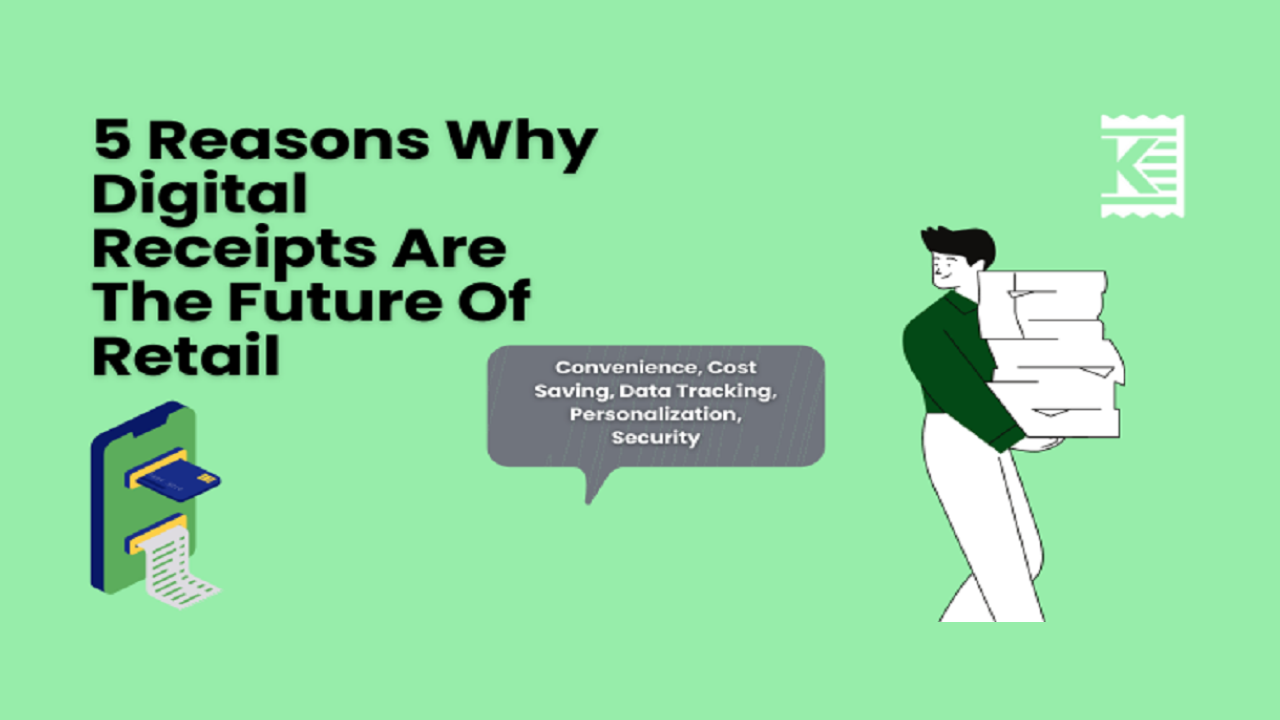In this blog post, we will discuss five reasons why digital receipts are becoming increasingly popular in the retail industry. From convenience to cost savings, discover why retailers and consumers alike are turning to digital receipts.

5 Reasons Why Digital Receipts are the Future of Retail
Going paperless is the way forward!
Introduction :
The retail industry is continuously evolving, driven by advancements in technology and changing consumer expectations. One significant trend that has emerged is the transition from traditional paper receipts to digital receipts. Also known as electronic or paperless receipts, digital receipts offer a host of benefits for both retailers and customers. In this blog post, we will explore the top five reasons why digital receipts are shaping the future of retail. From enhanced convenience and accessibility to sustainability and cost savings, digital receipts are revolutionizing the way transactions are documented and adding value to the overall retail experience. Join us as we delve into the exciting world of digital receipts and discover why they are becoming an essential component of modern retail operations.
Convenience :

Digital receipts have gained immense popularity due to the convenience they provide to consumers. One of the primary reasons behind this popularity is the elimination of the worry associated with misplacing or losing physical receipts. With digital receipts, customers can enjoy the ease of having their purchase information stored in one easily accessible place.
Unlike traditional paper receipts, digital receipts can be delivered through various channels such as email, text messages, or dedicated retailer apps. This flexibility allows customers to choose their preferred method of receiving and storing receipts. Whether they prefer to have receipts emailed directly to their inbox or stored within a retailer's app, the process is seamless and hassle-free.
The convenience of digital receipts becomes evident when customers need to retrieve their purchase information. Instead of sifting through piles of paper receipts or struggling to remember where a particular receipt was stored, customers can effortlessly access their digital receipts with just a few clicks. This not only saves time but also eliminates the frustration and stress associated with managing and organizing paper receipts.
Furthermore, digital receipts offer added benefits beyond convenience. They can provide detailed information about the purchased items, including product descriptions, quantities, and prices. This level of detail allows customers to review their purchases more accurately and facilitates easier returns or exchanges if needed.
Digital receipts also contribute to a more sustainable and eco-friendly approach. By reducing the need for paper receipts, the demand for paper and the associated environmental impact is significantly reduced. This aligns with the growing trend of environmentally conscious consumers who value businesses that adopt sustainable practices.
In summary, the convenience of digital receipts lies in their accessibility and ease of retrieval. Customers no longer need to worry about misplacing or organizing paper receipts as all their purchase information is stored digitally. With the option to receive receipts through email, text messages, or retailer apps, customers can effortlessly access their receipts whenever needed. This not only saves time but also eliminates the hassle of managing paper receipts. Additionally, digital receipts contribute to a more sustainable approach, reflecting the values of environmentally conscious consumers.
Cost Savings :

The adoption of digital receipts brings significant cost savings for both retailers and consumers. When retailers transition to digital receipts, they can experience substantial reductions in expenses associated with traditional receipt printing. The costs of printing receipts, including ink, paper, and printing supplies, can quickly add up, especially for larger retailers with a high volume of transactions. By eliminating the need for printing physical receipts, retailers can save a considerable amount of money. These cost savings can then be reinvested in other areas of the business, such as marketing campaigns, employee training, or improving the overall customer experience, leading to increased profitability and growth.
Digital receipts also contribute to cost savings from the consumers' perspective. With digital receipts, individuals no longer have to invest in expensive receipt storage solutions like folders or binders to keep track of their paper receipts. Digital receipts are stored electronically, reducing clutter and eliminating the need for physical storage space. This not only saves money but also makes it easier for consumers to organize and manage their receipts. Additionally, digital receipts align with environmental consciousness, as they reduce paper waste and the consumption of resources. This aspect makes digital receipts an attractive option for consumers who prioritize sustainability and are looking for ways to minimize their environmental impact.
By embracing digital receipts, both retailers and consumers can enjoy significant cost savings. Retailers can reduce expenses related to printing receipts, while consumers can save money on storage solutions and contribute to a more sustainable lifestyle. The shift to digital receipts not only brings financial benefits but also streamlines the receipt management process and aligns with the growing importance of sustainability in today's world.
Data Tracking and Analysis :

Digital receipts provide retailers with a wealth of valuable data that can unlock insights into customer behavior and preferences. Each transaction captured through digital receipts offers a window into the purchasing patterns of customers. Retailers can leverage this data to gain a deeper understanding of their customers, identify popular products, and track sales trends. For example, if a retailer notices that a specific product consistently sells out quickly, they can adjust their inventory levels to ensure they meet customer demand and avoid stockouts
The availability of detailed transaction data empowers retailers to personalize their offerings to individual customers. By harnessing the information collected from digital receipts, retailers can offer tailored recommendations and targeted promotions. For instance, if a customer frequently purchases running shoes, the retailer may provide them with a special discount or notify them about the latest models or accessories related to running. This level of personalization enhances the customer experience by showing that the retailer understands their preferences and needs. It fosters a sense of loyalty, as customers feel valued and appreciated, increasing the likelihood of repeat purchases and long-term customer relationships.
Furthermore, the data obtained from digital receipts enables retailers to optimize their marketing and sales strategies. By analyzing the transaction data, retailers can identify customer segments, preferences, and purchasing patterns. This information can guide decisions on product assortment, pricing strategies, and targeted advertising campaigns. For example, if the data reveals that a particular demographic group is more interested in eco-friendly products, the retailer can curate a collection that aligns with their values and preferences, leading to higher engagement and sales within that specific segment.
In summary, digital receipts provide retailers with a valuable source of data that can drive informed decision-making. From identifying trends and managing inventory to personalizing customer experiences and refining marketing strategies, the insights gained from digital receipts empower retailers to optimize their operations and foster long-lasting customer relationships. By leveraging the power of data, retailers can stay ahead in a competitive marketplace and deliver exceptional experiences that resonate with their customers.
Personalization and Customer Experience :

Digital receipts provide retailers with an opportunity to personalize the shopping experience for their customers. By analyzing the data collected from digital receipts, retailers can gain valuable insights into customers' preferences and purchase history. This information enables them to offer personalized recommendations, tailored promotions, and relevant product suggestions.
For instance, if a customer consistently purchases running shoes, a retailer may choose to offer that customer a discount on a new pair of running shoes or suggest related accessories. By leveraging the power of personalization, retailers can enhance customer satisfaction, build stronger relationships, and increase the likelihood of repeat purchases.
Personalized offers and recommendations not only benefit customers but also drive revenue growth for retailers. When customers feel that their needs are understood and catered to, they are more likely to engage with the brand and make additional purchases.
By harnessing the data captured through digital receipts, retailers can create a customized shopping experience that delights customers, fosters loyalty, and sets them apart from the competition.
Security :

When it comes to security, digital receipts offer distinct advantages compared to their physical counterparts. Physical receipts are prone to be lost, misplaced, or stolen, which can pose risks such as identity theft or unauthorized returns. In contrast, digital receipts provide a secure way for customers to access their purchase information. By retrieving their digital receipts through a retailer's dedicated app or website, customers can ensure that their transaction details are protected and accessible only to them. This added layer of security instills confidence and peace of mind, reducing the potential for fraudulent activities.
In addition to enhanced security, digital receipts contribute to environmental sustainability by reducing paper waste. The traditional practice of printing paper receipts generates a substantial amount of waste, consuming valuable resources and contributing to deforestation. By embracing digital receipts, retailers can demonstrate their commitment to environmental responsibility and appeal to consumers who prioritize eco-conscious choices. The elimination of paper receipts not only reduces the demand for paper but also minimizes the carbon footprint associated with their production, transportation, and disposal. This eco-friendly approach aligns with the growing global concern for sustainability and positions retailers as responsible stewards of the environment. By adopting digital receipts, retailers can play an active role in reducing paper waste and conserving valuable resources, making a positive impact on the planet.
Conclusion :
In conclusion, digital receipts are undeniably the future of retail. The numerous benefits they offer to both retailers and consumers make them a compelling alternative to traditional paper receipts. The convenience of having purchase information easily accessible, coupled with the cost savings for both parties, highlights the practicality and efficiency of digital receipts.
Moreover, the data tracking and analysis capabilities provided by digital receipts empower retailers to make data-driven decisions, optimize inventory management, and deliver personalized experiences to customers. The enhanced security and reduced environmental impact further strengthen the case for adopting digital receipts.
As the retail landscape continues to evolve, it is crucial for businesses to embrace digital transformation and leverage technologies that improve the customer experience. By incorporating digital receipts into their operations, retailers can enhance customer satisfaction, streamline processes, and gain valuable insights into consumer behavior.
Don't get left behind in this digital revolution. Embrace the future of retail with digital receipts and unlock a world of convenience, cost savings, data-driven insights, personalization, and security.
Frequently Asked Questions (FAQs)
Yes, digital receipts are legally recognized in many countries. They often meet the requirements set forth by tax authorities and can be used for accounting and expense management purposes.
While many retailers are transitioning to digital receipts, some may still offer paper receipts upon request. However, it's worth considering the benefits of digital receipts, such as convenience and environmental sustainability.
The storage duration of digital receipts can vary depending on the retailer or service provider. Some may retain the receipts for a specific period, while others offer long-term storage options. It's recommended to check with the retailer for their specific policies.
Retailers employ various security measures to protect customer data, including encryption and secure storage practices. However, it's essential to use reputable platforms and ensure your own devices are protected to minimize the risk of hacking or data breaches.
In most cases, digital receipts are accepted for returns or warranty claims. However, it's advisable to check with the retailer or manufacturer regarding their specific policies and requirements.